Impact Factor : 0.548
- NLM ID: 101723284
- OCoLC: 999826537
- LCCN: 2017202541
Joanna Igielska Kalwat1,2* and Ewa Kilian Pięta2
Received: May 05, 2023; Published: May 23, 2023
*Corresponding author: Joanna Igielska Kalwat, Faculty of Cosmetology, University of Education and Therapy, Grabowa 22, 61-473 Poznan, Symbiosis Laboratory, Symbiosis Sp. z o. o., Rubież 6H, 61-612 Poznan, Poland
DOI: 10.26717/BJSTR.2023.50.007972
Background and Aims: The aim of the study was to create cosmetic formulations used for washing and conditioning based on natural whey derived from tofu. Tofu whey used in the production of hair cosmetics turns out to be valuable waste that replaces water. Whey is an ingredient rich in proteins, oligosaccharides and isoflavones. When trying to follow the principles of sustainable development, we need also to be responsible for protecting water resources. Using whey, we limit water consumption to the necessary minimum. Hence, we also support no water waste trend. Tofu whey, which is a valuable waste that replaces water, was used in the production of masks and hair shampoos. The use of waste ingredients used in the production of tofu (whey) in cosmetics is called upcycling.
Methods: The research was conducted following the approval of the Bioethics Committee, resolution number 223/22. Tests confirming or excluding the properties and performance of tofu whey declared by the Ordering Party were carried out at probands’ homes and in the Dermatology Center (Centrum Dermatology) in Poznan. The probands were volunteers. A group of 60 people was selected for the study according to the indications for the use of the product submitted for experiments. The selection of probands was carried out after a preliminary assessment of the condition of their hair, scalp and health. Due to the intended use of the product, the study involved people who declared their willingness to improve the appearance and condition of the scalp and hair. The study used the imaging method involving a trichological microcamera.
Results: Patients with symptoms of skin peeling, seborrheic dermatitis and erythematous patches with yellow scabs. After 100 days of application of the Tofu Whey series, these symptoms completely disappeared.
Conclusion: On the basis of research carried out with the use of a scanning electron microscope (SEM) that enables observation of the topography of the tested hair, differences in its condition could be noticed.
Keywords: Tofu Whey; Sustainable Development; Upcycling, Tricho Scope Polarizer Dino-Lite (MEDL4HM); Scanning Electron Microscope (SEM); Cosmetics Formulations
Cosmetics manufacturers are looking for new solutions to make cosmetics effective and at the same time to maintain sustainable production, based on the integration of the production of raw materials and cosmetic mass. Thanks to this, the consumption of energy and water is reduced and the number of auxiliary substances in the cosmetic is minimized. The technology of the cosmetic products in question is oriented towards sustainable production based on the integration of the production of raw material components and cosmetic mass. Sustainable development is a trend which meets the needs of the present without prejudice to future generations to meet their own needs. It is a combination of environmental, economic and social aspects. In a company, sustainable development begins with the idea for the product. Another important element of the chain are raw materials - obtained from sustainable agriculture and in a responsible manner, in accordance with the rules of fair trade, limiting the use of water and chemicals. Production should ensure the health and safety of employees, minimize energy consumption and the emission of harmful substances. It is also important to choose appropriate packaging. Transport, sale, use also matter in the discussed trend [1- 5]. The most important motivation for the production of cosmetics containing whey from tofu was the waterless trend. Instead of the main base ingredient, which is water, tofu whey was used - a byproduct from the production of tofu coming from the food industry. The food industry is the branch of economy that consumes the most water. Food waste is thus a valuable resource. Therefore, the re-use of existing materials (upcycling) for the production of cosmetics has become the main technological task of the discussed cosmetics (Figure 1). The zero-waste trend, which promotes the reuse of existing materials for the production of cosmetics, has also been considered. Additionally, tofu whey is a multifunctional active ingredient.
Figure 1 The use of waste from the food industry in the production of cosmetics (Symbiosis Laboratory).

In the initial phase of the research, cosmetics from the trichological series were created with the aim of effective elimination of problems of the scalp and hair. Incidentally, the use of antimicrobial active substances has become part of the desired trends regarding skin and hair care during the coronavirus pandemic. The main ingredient of the series is tofu whey used in the amount of 1-5% of the total mass, depending on the product. Authors purchased the whey from the food manufacturers, The whey was obtained from a local farmer living near the authors’ place of residence.
Preparation of the Tofu whey Trichological Series
The preparation of cosmetics is presented below (Tables 1-2). The series consists of two products. (Figure 2) shows ready-made formulations.
Table 2: Ingredients of the Tofu whey trichological conditioner (Bio- Toforyou – Symbiosis Laboratory).
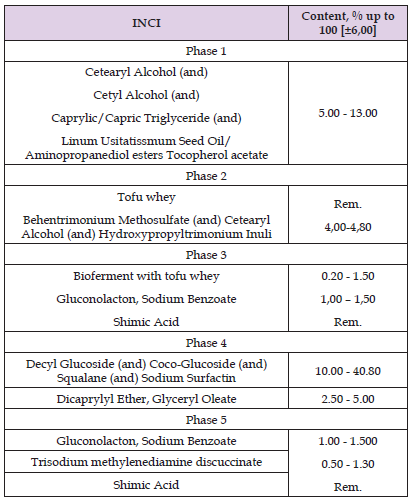
Preparation of Tofu Whey Trichological Shampoo: Phase I was prepared in a 100 ml beaker (basis weight and names of substances are given in Table 1). Phase I was heated to the temperature of about 60°C in a water bath, transferred to a magnetic stirrer, and allowed to reach the temperature of 40°C. Phase II was heated, combined with phase I and then homogenized for 20 minutes to a homogeneous consistency using the IKA T 50 basic Ultra-Turrax homogenizer with rotational speed of 6000 rpm [6,7]. The longer product is homogenized, the smaller is the emulsion’s droplet size, the better it can facilitate the penetration of actives. Knowing this parameter and keeping it consistent helps to control the effect of the product. Phase III was then weighed out, heated to 40°C, and added to the mixture while stirring. Phase IV and V was weighed, heated to 35°C and combined with other phases when the target temperature of 35°C was reached. The mixture was continuously vigorously stirred. It was left on the stirrer to cool. completely. Straw-colored shampoo was obtained (Figure 2). Considering the importance of the pH value, this value for all preparations was 5.50 ± 0.3. Furthermore, thanks to the intense smell of tofu whey, there is no added fragrance which in other cosmetics often causes skin irritation. The limits and qualitative recipes of the tested products are limited below.
Preparation of Tofu Whey Trichological Conditioner: The oil phase was prepared in a 100 ml beaker (basis weight and names of substances are given in Table 2). Phase I was melted in a water bath (80-85°C). Phase II was heated to the same temperature and then mixed. Both were stirred for 30 minutes. After the mixture had cooled to 55°C, it was homogenized for 20 minutes until a homogeneous emulsion was obtained with the IKA T 50 basic Ultra-Turrax homogenizer with rotational speed of 6000 rpm [6,7]. Phase III was heated to 35°C and combined with other phases when the target temperature of 35°C was reached. The mixture was continuously vigorously stirred. It was left on the stirrer to cool completely. A white homogeneous emulsion was obtained (Figure 2).
Safety Testing of Tofu Whey Trichological Series
In the subsequent part of the study, tests were performed in accordance with the Act on cosmetic products of October 4, 2018 [8]. Their aim was to assess the impact of the cosmetic on the safety of human health - including studies on skin tolerance to the tested cosmetic at the place of its application. Apparatus confirmation of the type of actions of the preparations declared by the Manufacturer was carried out. The research was conducted following the approval of the Bioethics Committee, resolution number 640/20 [9]. Tests confirming or excluding the properties and performance of the tofu whey, declared by the Ordering Party were carried out at probands’ homes and in the Dermatology Center (Centrum Dermatology) in Poznan under the supervision of a dermatologist, chemist and cosmetologist. The probands were volunteers. A group of 30 people was selected for the study, corresponding to the indications for the use of the product submitted for experiments. Probes with inflammation, seborrheic dermatitis, sensitive skin and damaged hair were recruited. The selection of probands was carried out according to the preliminary assessment of the condition of their hair, scalp and health. Due to the intended use of the product, the study involved people who declared their willingness to improve the appearance and condition of the scalp and hair. A group of 30 people was also collected - the placebo group used the preparation without the tested active ingredient.
**p<0.01 as a significant improvement from week 0 to week 14 (W14), determined by the post-hoc test. Total trial group (n=60). Measurements were taken every fourteen weeks.
Methodology of the Research: At Home (Home Panel)
Subjects qualified for the study received one package containing shampoo and conditioner. They undertook to use the received sample on a regular basis in accordance with the application rules suggested by the manufacturer. Subjects should not use preparations with the same or analogous purpose during the study. Volunteers were to observe the reaction of the scalp and hair at the application sites. They should read the notes on the functional properties of the tested cosmetic in detail. In the event of any negative symptoms at the place of application of cosmetics, they were to stop using cosmetics and immediately contact the person conducting the test. It was recommended to use the preparations twice a week. The days of serry application were fixed; it was Wednesday and Saturday. The results of the experiment could only be influenced by factors such as health, type and condition of hair and skin, genetics, individual characteristics, individual preferences, lifestyle and environmental conditions. Therefore, each of the probes was provided with documentation, in which all additional information was marked. The products were used in the amount of one pump (1 gram) for the shampoo and two for the mask (2 grams). A group of 30 people was also collected - the placebo group used the preparation without the tested active ingredient.
Imaging Analysis using TrichoScope Polarizer Dino-Lite (MEDL4HM)
The research used the imaging method involving a trichological microcamera for the assessment of the condition of the skin and the follicular area. TrichoScope Polarizer Dino-Lite (MEDL4HM) is a device designed for the examination of the scalp and hair analysis. Owing to very high magnification up to 200 times, a single hair can be viewed in great detail. The built-in polarization filter minimizes the effect of glare on the scalp or hair [1,10,11]. As already mentioned, the Tofu whey trichological series study was conducted in cooperation with the Symbiosis Dermatology Center on a group of 30 probands. Before starting the test, each volunteer was assigned a cosmetic sample. For the subsequent 100 days, the study participants were asked to test the samples at home (in-home-use-test methodology) [12]. With the help of a microcamera, the experimenter examined the condition of the scalp area and hair of the patients before and after using the preparations. A blank analysis was performed prior to starting product application. The second test was carried out after 100 days, during which the probands undertook to use the preparation regularly. The studies were also carried out on the placebo group, n = 30.
Imaging Analysis using the SEM (Scanning Electron Microscope) Method
During the blind test, hair was collected from both probes’ temples, the center of the head and the occiput for imaging studies using the SU3800 / SU3900 scanning electron microscope. The distance between the hair and the scalp was the same for all the test sites and probes, 1 cm. SEM is a type of electron microscope that allows you to observe the topography of the material (hair) under study. It is used to observe materials on a nanometric to micrometric scale. Thanks to scanning microscopy, it is possible to precisely determine the morphology of the hair, the condition of the hair bulb and hair shaft, the type and size of damage to the hair tissue, as well as to identify factors affecting the hair to determine its structural changes or analyze its chemical composition. After a hundred days, the test was repeated. Subsequent samples were taken from all probes and imaging by SEM. All participants remained in the study until the end of 1. The studies were also carried out on the placebo group, n = 30.
Instrument Tests Carried Out with the TrichoScope Polarizer Dino-Lite (MEDL4HM)
Probands using the Tofu whey trichological series were tested during the blank test and after 100 days. The research used the imaging method involving a trichological micro camera with the assessment of the condition of the skin and the follicular area (TrichoScope Polarizer Dino-Lite (MEDL4HM). A compilation of photos presented below shows the difference before the application of Tofu whey trichological series and after the 100-day study. In the most severe cases, the frequency of follow-up examinations was increased. The photos below were taken of different areas of the scalp. the majority of the subjects had seboreic dermatitis. The (Figures 3-6) below was taken of different areas PATIENT X and Y (blank determination) - a group of patients who started using a whey product with tofu for the scalp. In addition, people who applied only the bases without the leading active substance were tested as a control group.
PATIENT X and Y (Blank Determination)
(Figures 3 & 4).Figure 3 Photo of the scalp from probands X and V before the application of the Tofu whey trichological series.

Figure 4 Photo of the scalp from probands X and V people who applied only the bases without the leading active substance were tested as a control group.
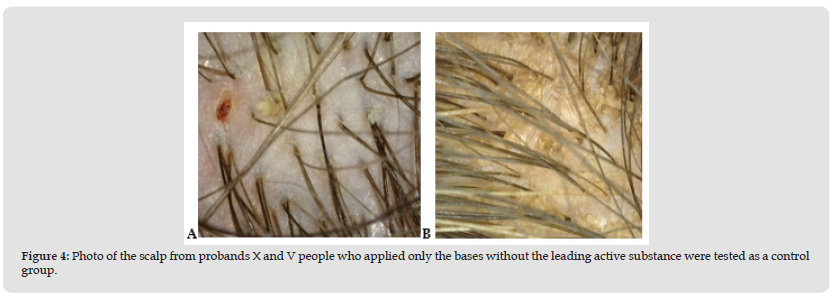
PATIENT X and Y (Test After 100 Days)
(Figures 5 & 6).
Figure 5 Photo of the scalp from probands X and V after 100 days of application of the Tofu whey trychological series.
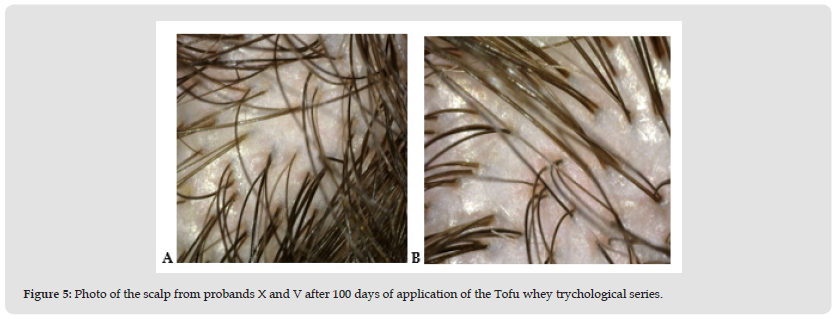
Figure 6 Photo of the scalp from probands X and V after 100 days people who applied only the bases without the leading active substance were tested as a control group.
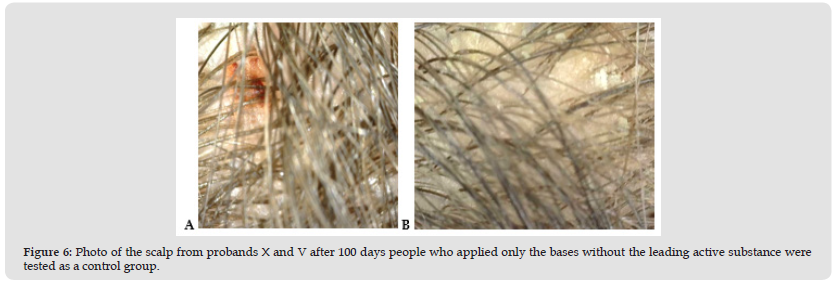
The above-mentioned patients had symptoms of peeling skin. As seborrheic dermatitis progressed, the lesions turned into irregular, erythematous patches with yellow scabs. There were also diffuse inflammatory lesions covering the entire surface of the scalp. The dried layer of dead skin and sebum has formed a crust. In addition, the patient complained of itching. After 100 days, thanks to the use of the Tofu whey series, the symptoms completely disappeared.
Apparatus Test Performed using the SEM (Scanning Electron Microscope) Method
On the basis of tests carried out with the use of a scanning electron microscope (SEM), which allows the observation of the topography of the tested hair, differences in its condition can be noticed (blank test and tests after 100 days). The photo juxtaposition below shows the difference before applying the tofu whey series before and after the 100-day study. In the most severe cases, the frequency of followup examinations was increased. The photos below were taken from different areas of the scalp. In addition, people who used only bases that did not contain the main ingredient for the scalp and hair were tested as a control group. The (Figures 7-10) below was taken of different areas PATIENT X and Y (blank determination) a group of patients who started using a whey product with tofu for the hair. In addition, people who applied only the bases without the leading active substance were tested as a control group.
PATIENT X and Y (Blank Determination)
(Figures 7 & 8).
Figure 7 A. Photo of proband X hair before applying the tofu whey series (50 microns × 890, 15 kilowatt hours). B. Photo of probands Y hair before applying the tofu whey series (50 microns × 910, 12 kilowatt hours).
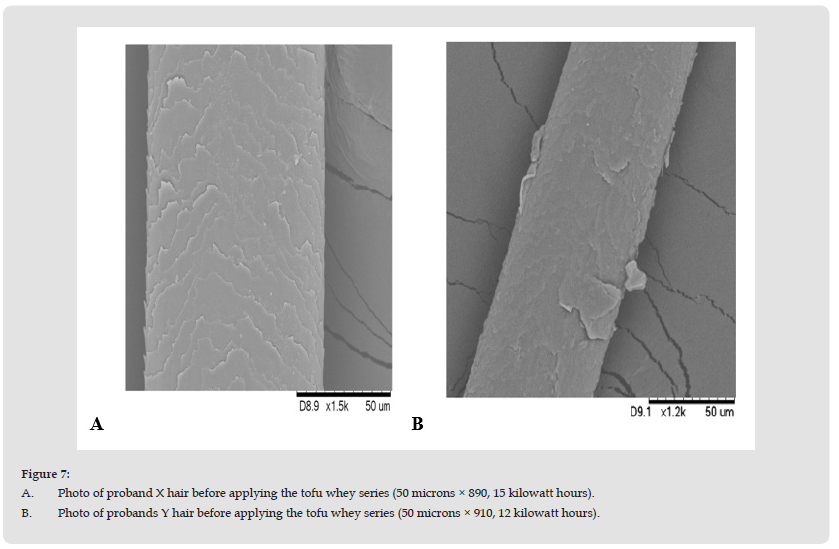
Figure 8 A. Photo of the hair of probant X using base-only care products (50 microns × 900, 11 kilowatt hours). B. Photo of the hair of probant Y using base-only care products (50 microns x 900, 15 kilowatt hours).
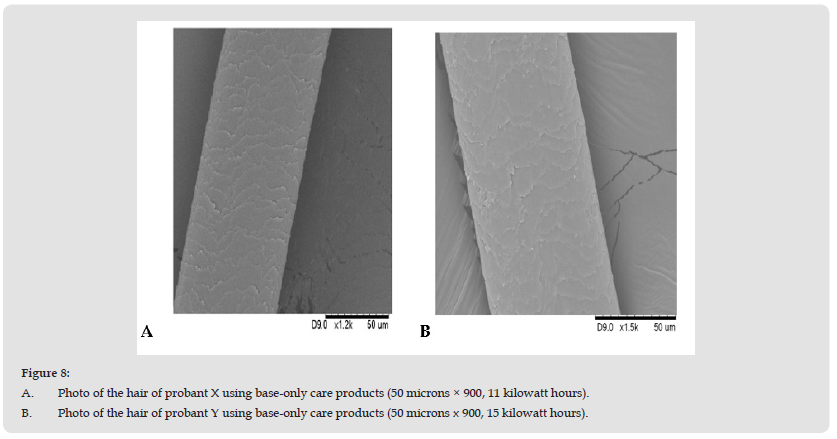
PATIENT X and Y (Test After 100 Days)
(Figures 9 & 10).
Figure 9 A. Photo of the hair of probant X after 100 days when using a series of tofu whey (50 microns × 890, 15 kilowatt hours). B. Removal of the hair from probant Y after 100 days of application series (50 microns × 900, 15 kilowatt hours).
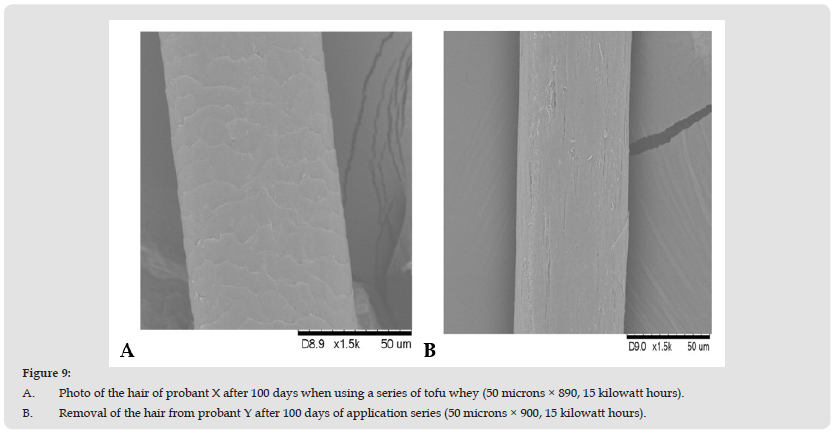
Figure 10 A. Photo of the hair of proband X after 100 days if application only base series (50 microns × 900, 12 kilowatt hours). B. Photo of the hair of proband Y after 100 days of application series (50 microns × 870, 15 kilowatt hours).

After one hundred days of use, the following properties of the series can be confirmed: moisturizing, nourishing, regenerating, cleansing (closing the hair cuticle) and improving the condition of the hair.
The applied active substances contributed to the remission of the disease, mainly whey obtained from tofu and a bioferment. Due to the high content of soybean white, calcium, phosphorus and isoflavones, which mimic the effects of natural hormones - estrogens, the beneficial effects of this series were not noticeable. Tofu whey has a strong antibacterial effect, soothes inflammation thanks to the content of soy isoflavones, the main representative of which in soybeans is genistein [13]. Recent reports suggest that soy isoflavones may alleviate neurodegenerative diseases such as Alzheimer’s disease. This is the case, inter alia, thanks to their anti-inflammatory properties. During regular use, the content of tofu seaweed reduced inflammation. Probands who used only bases noticed only the effect of cleaning the scalp, inflammation still remained. As seborrheic dermatitis progressed, the lesions turned into irregular erythematous spots with yellow scabs. There were also diffuse inflammatory lesions covering the entire surface of the scalp. The dried layer of dead skin and sebum formed a crust. Moreover, the patients complained of itching. The hair was also thinned. After 100 days, thanks to the application of the tofu cosmetics the symptoms are completely gone. After a hundred days of use, the following properties of the series can be confirmed: hydration, nourishment, regeneration, cleansing (closing the hair cuticle) and improving the hair condition. Based on the results of SEM imaging, it can be concluded that the active substances used in cosmetics contributed primarily to improving the condition of the hair when using the series. The active substances used in cosmetics contributed primarily to the improvement of the condition of the hair during the application of the series. As can be seen in the photos showing the hair before the application of the preparation, it was damaged and was characterized by a hair sheath with open cuticles. A casing consisting of open scales gradually ceases to fulfill its protective function. The scales open, among others under the influence of alkaline pH and heat - high insolation, mechanical treatments, poor styling with the use of aggressive chemicals. Open cuticles make the hair lose water faster and become dry, dull, coarse and more sensitive to external factors. After using the series, similarly positive results were noted in the remaining probands [14]. It should be noted, however, that the base of the tofu whey series, thanks to the use of effective emollients and oily substances, including Cetearyl Alcohol, Cetyl Alcohol, Caprylic / Capric Triglyceride, Linum Usitatissmum Seed Oil / Aminopropanediol esters Tocopherol acetate, improved the hair concentration and moderate hair closure [10,15,16]. By means of imaging, we can say that the surface part of the stem after the applied series looks healthier. Ad-ditionally, Linum Usitatissmum Seed Oil proteins and panthenol were added to the formulation. These substances also contributed to the restoration of the proper function of the hydro-lipid coat. The hair structure was rebuilt [17]. It might be stated that the appearance of the hair will improve as the preparation is further used. The above-mentioned active substances contributed to the filling of the defects of the outer layer of the hair and strengthened the internal structure of the hair fiber. The introduction of the conditioner in the form of a liquid crystal emulsion resulted in faster and more effective absorption of the ingredients into the scalp and hair. Owing to its universal base, the tofu whey conditioner is intended not only for oily hair but also for hair with different porosity. It contains active substances that moisturize, nourish and improve the structure of the hair.
The aim of the work was to present natural substitutes for aggressive chemical substances, including primarily: tofu whey, benzyl benzoate, Linum Usitatissmum seed oil, hydroxypropyltrimonium inuli, xylityl glucoside, anhydroxylitol, xylitol, sodium hyaluronate, gluconolactone and bioferment tofu whey. All of them have been introduced into the trichological formula of the Tofu Whey series. This series is intended to reduce or completely eliminate the symptoms of seborrheic scalp inflammation. The raw materials have a multifunctional effect. The causes of seborrheic dermatitis are not fully understood. Various hypotheses claim that the causes of the disease include increased production of sebum and improper composition of sebum, the yeast-like Malassezia furfur fungus and inflammation caused by all above factors. It has also been confirmed that the Staphylococcus epidermidis bacterium and disturbances of the skin barrier function have an influence on the development of the disease. Factors that increase the likelihood of developing seborrheic dermatitis have also been established. They include neurological diseases (e.g. Parkinson’s disease, epilepsy) and mental disorders, stress, weakened immune system (e.g. due to HIV/AIDS or certain cancers), use of selected drugs (e.g. haloperidol, lithium, psolarenes, gold salts, buspirone), improper diet (alcohol and nutritional deficiencies of e.g. zinc, selenium or B vitamins), errors in skin care and overuse of cosmetics. Hence, the selection of components of the tested series was particularly important. The main ingredients were the Tofu whey and gluconolactone which have been proven to have antibacterial, antiviral, antifungal and antiparasitic properties. Tofu whey contains isoflavones. The use of these substances eliminated seborrheic dermatitis and made it possible to avoid controversial chemicals such as ciclopiroxolamine, ketoconazole or zinc pyritonate; long-term use of these may lead to deterioration of the patient’s condition [15]. Abuse of these substances also leads to resistance to their effects. Photographs taken with a scanning electron microscope after 100 days of application of the series show the closure of the cuticular scales. Closed scales testify to the increased effect of smooth, moisturized and nourished hair with a natural glow and improved condition. Closing the cuticles was possible by supplying the hair with active substances contained in the cosmetic, such as the Tofu whey, Hydroxypropyltrimonium Inuli, Xylitylglucoside, Anhydrroxylitol, and Xylitol. These compounds strengthen the hair fibers, smooth its surface, improve resistance and provide shine. They also reduce surface damage. They preventive effect reduces breaking hair and split ends [18,19]. The active substances used in the cosmetics contributed mostly to the improvement of the condition of the hair during the application of the series. As can be seen in the photos showing the hair before using the preparation, it was damaged and characterized by hair sheath of open cuticles.


